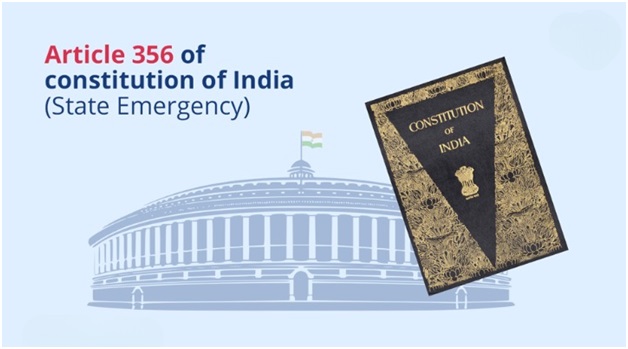Article 356 of the Indian Constitution (The Hindu)

- 12 Dec 2023
Why is it in the News?
The Supreme Court recently held that the declaration of State emergency under Article 356 and the subsequent actions of the President should have a “reasonable nexus”.
What is Article 356 of the Indian Constitution?
Article 356 of the Constitution of India is based on Section 93 of the Government of India Act, 1935. According to Article 356, the President's Rule can be imposed on any state of India on the grounds of the failure of the constitutional machinery.
There are two types:
- If the President receives a report from the state's Governor or otherwise is convinced or satisfied that the state's situation is such that the state government cannot carry on the governance according to the provisions of the Constitution.
- Article 365: As per this Article, President's Rule can be imposed if any state fails to comply with all directions given by the Union on matters it is empowered to.
In simple words, President's Rule is when the state government is suspended and the central government directly administers the state through the office of the governor (centrally appointed. It is also called State Emergency or Constitutional Emergency.
President's Rule:
- Parliamentary approval is necessary for the imposition of the President's Rule on any state.
- The proclamation of President's Rule should be approved in both Houses of Parliament within two months of its issue.
- The approval is through a simple majority.
- The President's Rule is initially for a period of six months.
- Later, it can be extended for a period of three years with parliamentary approval, every six months.
- The 44th Amendment to the Constitution (1978) brought in some constraints on the imposition of the President's Rule beyond a period of one year. It says that the President's Rule cannot be extended beyond one year unless:
- There is a national emergency in India.
- The Election Commission of India certifies that it is necessary to continue the President's Rule in the state because of difficulties in conducting assembly elections in the state.
What happens after the President's Rule is imposed?
- The governor carries on with the administration of the state on behalf of the President. He or she takes the help of the state's Chief Secretary and other advisors/administrators whom he or she can appoint.
- The President has the power to declare that the state legislature's powers will be exercised by the Parliament.
- The state legislative assembly would be either suspended or dissolved by the President.
- When the Parliament is not in session, the President can promulgate ordinances with respect to the state's administration.
When is the President's Rule imposed?
- President's Rule is typically imposed when any of the following circumstances occur:
- The state legislature is unable to elect a leader as the Chief Minister within the time prescribed by the state's governor.
- Breakdown of a coalition in the state government, resulting in the Chief Minister having minority support in the legislature, and the CM is unable to prove a majority within the time prescribed by the governor.
- A vote of no confidence in the legislative assembly leads to a loss of majority.
- Postponement of elections due to unavoidable reasons such as a natural disaster, epidemic, or war.
Revocation of President's Rule:
- President's Rule can be revoked anytime after such a proclamation has been made by a subsequent proclamation by the President.
- A proclamation of revocation does not require approval by the Parliament.
- This occurs when the leader of a political party produces letters indicating majority support for him in the assembly and stakes his claim to form the state government.
